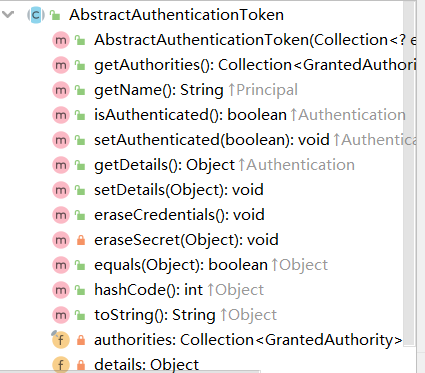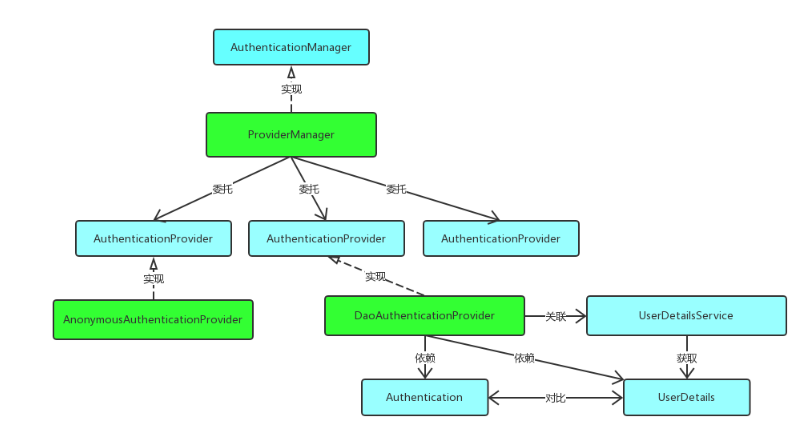Spring Security认证器实现
一些权限框架一般都包含认证器和决策器,前者处理登陆验证,后者处理访问资源的控制
Spring Security的登陆请求处理如图

下面来分析一下是怎么实现认证器的
拦截请求
首先登陆请求会被UsernamePasswordAuthenticationFilter拦截,这个过滤器看名字就知道是一个拦截用户名密码的拦截器
主要的验证是在attemptAuthentication()方法里,他会去获取在请求中的用户名密码,并且创建一个该用户的上下文,然后在去执行一个验证过程
String username = this.obtainUsername(request);
String password = this.obtainPassword(request);
//创建上下文
UsernamePasswordAuthenticationToken authRequest = new UsernamePasswordAuthenticationToken(username, password);
this.setDetails(request, authRequest);
return this.getAuthenticationManager().authenticate(authRequest);
可以看看UsernamePasswordAuthenticationToken这个类,他是继承了AbstractAuthenticationToken,然后这个父类实现了Authentication

由这个类的方法和属性可得知他就是存储用户验证信息的,认证器的主要功能应该就是验证完成后填充这个类
回到UsernamePasswordAuthenticationToken中,在上面创建的过程了可以发现
public UsernamePasswordAuthenticationToken(Object principal,Object credentials){
super(null);
this.principal=principal;
this.credentials=credentials;
//还没认证
setAuthenticated(false);
}
还有一个super(null)的处理,因为刚进来是还不知道有什么权限的,设置null是初始化一个空的权限
//权限利集合
private final Collection<GrantedAuthority> authorities;
//空的集合
public static final List<GrantedAuthority> NO_AUTHORITIES = Collections.emptyList();
//初始化
if (authorities == null) {
this.authorities = AuthorityUtils.NO_AUTHORITIES;
return;
}
那么后续认证完还会把权限设置尽量,此时可以看UsernamePasswordAuthenticationToken的另一个重载构造器
//认证完成
public UsernamePasswordAuthenticationToken(Object principal, Object credentials,
Collection<? extends GrantedAuthority> authorities) {
super(authorities);
this.principal = principal;
this.credentials = credentials;
super.setAuthenticated(true); // must use super, as we override
}
在看源码的过程中,注释一直在强调这些上下文的填充和设置都应该是由AuthenticationManager或者AuthenticationProvider的实现类去操作
验证过程
接下来会把球踢给AuthenticationManager,但他只是个接口
/**
* Attempts to authenticate the passed {@link Authentication} object, returning a
* fully populated <code>Authentication</code> object (including granted authorities)
* if successful.
**/
public interface AuthenticationManager {
Authentication authenticate(Authentication authentication)
throws AuthenticationException;
}
注释也写的很清楚了,认证完成后会填充Authentication
接下来会委托给ProviderManager,因为他实现了AuthenticationManager
刚进来看authenticate()方法会发现他先遍历了一个List<AuthenticationProvider>集合
/**
* Indicates a class can process a specific Authentication
**/
public interface AuthenticationProvider {
Authentication authenticate(Authentication authentication)
throws AuthenticationException;
//支不支持特定类型的authentication
boolean supports(Class<?> authentication);
}
实现这个类就可以处理不同类型的Authentication,比如上边的UsernamePasswordAuthenticationToken,对应的处理类是AbstractUserDetailsAuthenticationProvider,为啥知道呢,因为在这个supports()里
public boolean supports(Class<?> authentication) {
return (UsernamePasswordAuthenticationToken.class
.isAssignableFrom(authentication));
}
注意到这个是抽象类,实际的处理方法是在他的子类DaoAuthenticationProvider里,但是最重要的authenticate()方法子类好像没有继承,看看父类是怎么实现这个方法的
首先是继续判断
Authentication是不是特定的类Assert.isInstanceOf(UsernamePasswordAuthenticationToken.class, authentication,
() -> messages.getMessage(
"AbstractUserDetailsAuthenticationProvider.onlySupports",
"Only UsernamePasswordAuthenticationToken is supported"));
查询根据用户名用户,这次就是到了子类的方法了,因为这个方法是抽象的
user=retrieveUser(username,
(UsernamePasswordAuthenticationToken)authentication);
接着
DaoAuthenticationProvider会调用真正实现查询用户的类UserDetailsServiceUserDetails loadedUser = this.getUserDetailsService().loadUserByUsername(username);
UserDetailsService这个类信息就不陌生了,我们一般都会去实现这个类来自定义查询用户的方式,查询完后会返回一个UserDetails,当然也可以继承这个类来扩展想要的字段,主要填充的是权限信息和密码检验用户,如果获取到的
UserDetails是null,则抛异常,不为空则继续校验//检验用户合法性
preAuthenticationChecks.check(user);
//校验密码
additionalAuthenticationChecks(user,
(UsernamePasswordAuthenticationToken) authentication);
第一个教育是判断用户的合法性,就是判断
UserDetails里的几个字段//账号是否过期
boolean isAccountNonExpired();
//账号被锁定或解锁状态。
boolean isAccountNonLocked();
//密码是否过期
boolean isCredentialsNonExpired();
//是否启用
boolean isEnabled();
第二个则是由子类实现的,判断从数据库获取的密码和请求中的密码是否一致,因为用的登陆方式是根据用户名称登陆,所以有检验密码的步骤
String presentedPassword = authentication.getCredentials().toString();
if (!passwordEncoder.matches(presentedPassword, userDetails.getPassword())) {
logger.debug("Authentication failed: password does not match stored value");
throw new BadCredentialsException(messages.getMessage(
"AbstractUserDetailsAuthenticationProvider.badCredentials",
"Bad credentials"));
}
需要主要的是请求中的密码是被加密过的,所以从数据库获取到的密码也应该是被加密的
注意到当完成校验的时候会把信息放入缓存
//当没有从缓存中获取到值时,这个字段会被设置成false
if (!cacheWasUsed) {
this.userCache.putUserInCache(user);
}
//下次进来的时候回去获取
UserDetails user = this.userCache.getUserFromCache(username);如果是从缓存中获取,也是会走检验逻辑的
最后完成检验,并填充一个完整的
Authenticationreturn createSuccessAuthentication(principalToReturn, authentication, user);
由上述流程来看,Security的检验过程还是比较清晰的,通过AuthenticationManager来委托给ProviderManager,在通过具体的实现类来处理请求,在这个过程中,将查询用户的实现和验证代码分离开来
整个过程看着像是策略模式,后边将变化的部分抽离出来,实现解耦
返回完整的Authentication
前边提到的认证成功会调用createSuccessAuthentication()方法,里边的内容很简单
UsernamePasswordAuthenticationToken result = new UsernamePasswordAuthenticationToken(
principal, authentication.getCredentials(),
authoritiesMapper.mapAuthorities(user.getAuthorities()));
result.setDetails(authentication.getDetails());
public UsernamePasswordAuthenticationToken(Object principal, Object credentials,
Collection<? extends GrantedAuthority> authorities) {
super(authorities);
this.principal = principal;
this.credentials = credentials;
super.setAuthenticated(true); // must use super, as we override
}
这次往supe里放了权限集合,父类的处理是判断里边的权限有没有空的,没有则转换为只读集合
for (GrantedAuthority a : authorities) {
if (a == null) {
throw new IllegalArgumentException(
"Authorities collection cannot contain any null elements");
}
}
ArrayList<GrantedAuthority> temp = new ArrayList<>(
authorities.size());
temp.addAll(authorities);
this.authorities = Collections.unmodifiableList(temp);
收尾工作
回到ProviderManager里的authenticate方法,当我们终于从
result = provider.authenticate(authentication);
走出来时,后边还有什么操作
- 将返回的用户信息负责给当前的上下文
if (result != null) {
copyDetails(authentication, result);
break;
}
删除敏感信息
((CredentialsContainer) result).eraseCredentials();
这个过程会将一些字段设置为null,可以实现
eraseCredentials()方法来自定义需要删除的信息
最后返回到UsernamePasswordAuthenticationFilter中通过过滤
结论
这就是Spring Security实现认证的过程了

通过实现自己的上下文Authentication和处理类AuthenticationProvider以及具体的查询用户的方法就可以自定义自己的登陆实现
具体可以看Spring Security自定义认证器
最新文章
- LockSupport
- Python之路----------shutil模块
- Asp.NET Visible属性与HTML display:none
- RTTI 运行时类型识别 及异常处理
- 【Todo】【转载】深度学习&神经网络 科普及八卦 学习笔记 & GPU & SIMD
- Python的安装与基本语法
- XCODE真机调试设备连接一直忙碌如何处理
- 利用java开发一个双击执行的小程序
- 导入android项目在eclipse中会报@Override错误
- php 数组去除空值
- java 学习 ——计算器小程序
- unbuntu下的root 用户和 sudo 命令
- spring security 配置多个AuthenticationProvider
- Elastic Stack
- Handlebars 新手使用
- PDA开发数据由本地上传至DB
- idea Unable to open debugger port (127.0.0.1:58006) Address already in use: JVM_Bind 的解决办法
- [UE4]如何编译部署独立专用服务端(Standalone Dedicated Server)
- 第五章 HashMap源码解析
- 如何查看VisualStudio的编译, 链接命令